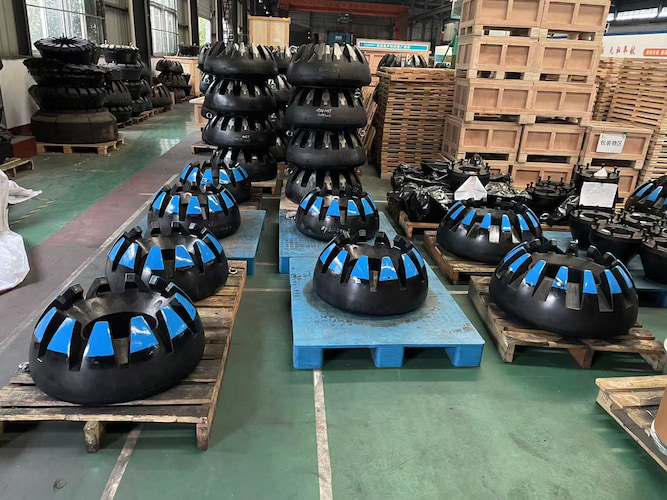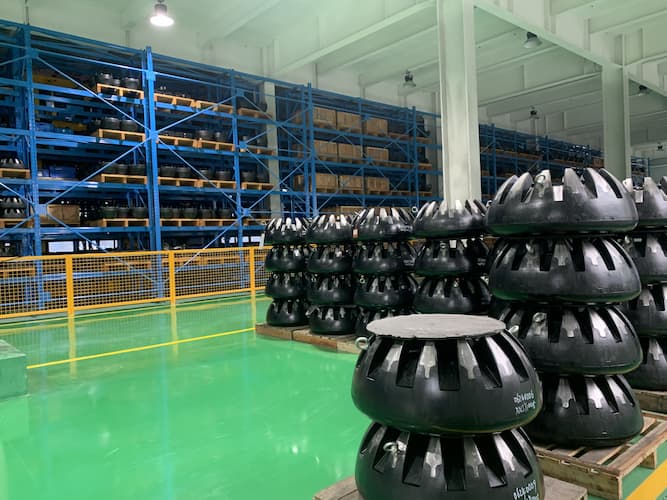What are the sealing elements of blowout preventers in the oil drilling industry?
Mar 05, 2025
In the oil drilling industry, the blowout preventer sealing elements mainly include the following types:
Ⅰ. Packing Elements of Annular Blowout Preventer
There are two types of annular packing element.
Annular Packing Element GK Type: It is conical in shape and generally composed of rubber and a metal framework. Under the action of the hydraulic control pressure oil, the piston moves upward. Restricted by the top cover, the annular packing element is squeezed towards the center of the wellbore under the action of the inner conical surface of the piston, thus sealing the annular space of the wellhead. When there is no drill string in the well, it can fully seal the wellhead.
Annular Packing Element Spherical Type:It is hemispherical in shape and is composed of multiple bow-shaped rubber blocks combined with metal hemispherical blocks. When closing the well, the piston pushes the annular packing element to squeeze and deform towards the center of the wellbore to achieve sealing. It has better wear resistance and erosion resistance, and can adapt to higher pressures and harsher working conditions.
Advantages of the Packing Elements of the Annular Blowout Preventer:
Wide Sealing Range: When there are drill strings, tubing or casing in the well, it can seal various annular spaces of different sizes; when the well is empty, it can fully seal the wellhead. During operations such as drilling, milling, casing grinding, logging, and fishing for downhole lost objects, if there is overflow or blowout, it can seal the space formed between the kelly, cable, wire rope, and the tools for handling accidents and the wellhead.
Simple Operation: Only by pushing the piston through hydraulic pressure to make the annular packing element move can the wellhead be closed and opened. The action is rapid, and it can respond quickly to seal the well in case of an emergency.
Forcible Tripping and Running of Drill Pipe: With the cooperation of a pressure reducing and regulating valve or a small accumulator, it can perform the operation of forcibly tripping and running drill pipe tools on the 18° butt-welded pipe string joints without fine threads, which improves the flexibility of the operation to a certain extent.
Soft Well Closing Function: In case of severe overflow or blowout, it can cooperate with the ram blowout preventer and the choke manifold to achieve soft well closing, which is beneficial to protecting the wellhead equipment and controlling the pressure in the well.
Ⅱ. Sealing Elements of Ram Blowout Preventer
Ram Rubber Core: It is usually installed on the ram of the ram blowout preventer, and the material is mostly rubber or a composite material of rubber and metal. There are full closing ram rubber cores and half closing ram rubber cores. The full closing ram rubber core is used to fully seal the wellhead when there is no drill pipe; the half closing ram rubber core is used to hold the drill pipe body and seal the annular space between the drill pipe and the wellhead.
Advantages of the Sealing Elements of the Ram Blowout Preventer:
High Pressure Bearing Capacity: It can withstand high wellhead pressures. Common ram blowout preventer rubber cores can withstand pressures of 35MPa, 70MPa or even higher, ensuring effective sealing under high-pressure working conditions.
Good Wear Resistance: Due to frequent contact and friction with the drill pipe, the rubber core material has high wear resistance. For example, wear-resistant materials such as nitrile rubber are used, and wear-resistant fillers are added to extend the service life.
Corrosion Resistance: The fluids in oil and gas wells contain corrosive media such as hydrogen sulfide and carbon dioxide. The rubber core material needs to have corrosion resistance. For example, rubbers with good corrosion resistance such as fluororubber are used, or surface anti-corrosion treatment is carried out.
Ⅲ. Sealing Elements of Rotating Blowout Preventer
Rotating BOP Sealing Element: It is the core sealing component of the rotating blowout preventer and is generally made of special rubber materials. It can achieve wellhead sealing when the drill string is rotating. The rotating bop sealing element is pressed by hydraulic drive to seal the wellhead, and the well sealing pressure can be automatically compensated according to the well pressure.
Good Wear Resistance: The rotating bop sealing element needs to be in frequent contact and friction with the rotating and moving up and down drill string. Therefore, rubber materials with good wear resistance, such as nitrile rubber (NBR) or hydrogenated nitrile rubber (HNBR), etc., should be used.
High Pressure Resistance: It can withstand a certain wellhead pressure to ensure effective sealing during the operation under pressure and prevent the fluid in the well from spraying out.
Temperature and Corrosion Resistance: The fluids in the oil and gas well environment may have characteristics such as high temperature and corrosion. The rotating bop sealing element material should have temperature and corrosion resistance to adapt to different working environments.
Ⅳ. To select suitable blowout preventer sealing elements for the oil drilling industry, multiple factors need to be comprehensively considered. The following are the specific selection points:
1.Drilling Working Conditions
Pressure and Temperature: Accurately understand the maximum pressure and temperature range that may be encountered during the drilling operation. Different sealing elements have different temperature and pressure resistance performances. For example, in high-temperature and high-pressure wells, fluororubber or metal sealing elements may be more suitable because fluororubber can maintain good sealing performance at relatively high temperatures (up to about 200°C) and high pressures, and metal sealing elements can withstand higher pressures and temperatures; while in low-temperature and low-pressure environments, nitrile rubber sealing elements may be able to meet the requirements.
Properties of Drilling Fluid: Determine the type of drilling fluid (such as oil-based drilling fluid, water-based drilling fluid, synthetic-based drilling fluid, etc.), the pH value, as well as the additives and impurities contained in it. Oil-based drilling fluids have higher requirements for the oil resistance of the sealing elements, and nitrile rubber has good resistance to oils; if the drilling fluid is strongly acidic or alkaline, sealing element materials with good chemical corrosion resistance need to be selected, such as fluororubber or some special composite materials.
Wellbore Size and Drill String Type: Select suitable sealing elements according to the diameter of the wellbore and the size and type of the drill string (such as drill pipe, drill collar, casing, etc.) used. Different wellbore sizes and drill string combinations require the sealing elements to have corresponding sizes and shapes to ensure a good sealing effect. For example, the annular packing element spherical type has good adaptability to different sizes of drill strings, while the ram rubber core of the ram blowout preventer needs to be selected according to the specific size of the drill string.
2.Performance Characteristics of Sealing Element
Sealing Performance: This is the key factor in selecting sealing elements. Consider the sealing reliability of the sealing elements under different working conditions, such as static and dynamic sealing performances. For example, the sealing elements of the rotating blowout preventer need to have good dynamic sealing performance and be able to effectively prevent the fluid in the well from leaking when the drill string is rotating; while the sealing elements of the annular blowout preventer need to be able to achieve reliable sealing in various drill string states (with drill string, without drill string).
Wear Resistance: During the drilling process, the sealing elements will rub against the drill string and drilling fluid, so they need to have good wear resistance. Composite material sealing elements containing reinforcing fibers or particles, or rubber sealing elements with special surface treatment, usually have better wear resistance and can extend the service life.
Elasticity and Recovery: The sealing elements should have good elasticity so that they can quickly return to their original shape after being subjected to pressure and friction to maintain the sealing performance. Rubber sealing elements usually have good elasticity, but different types of rubber also have different elasticities and recovery abilities, and need to be selected according to specific working conditions.
3.Type and Structure of Blowout Preventer
Annular Blowout Preventer: For the annular blowout preventer, the Annular Packing Element GK Type and the Annular Packing Element Spherical Type are common sealing elements. The Annular Packing Element GK Type is suitable for general working conditions and has a relatively low cost; the Annular Packing Element Spherical Type has better sealing performance and adaptability to different drill strings, and is suitable for more complex working conditions, but the cost is higher. When selecting, it is necessary to decide according to the specific requirements and budget of the drilling operation.
Ram Blowout Preventer: The selection of the ram rubber core should be determined according to the size of the drill string and the wellbore conditions, and the full closing ram rubber core and the half closing ram rubber core should be correctly selected.
Rotating Blowout Preventer: The material and structural design of the rotating BOP sealing element have a great influence on its performance, and it is necessary to select products with good rotating sealing performance and durability.
4.Quality and Reliability
Quality Certification and Standards: Ensure that the sealing elements meet relevant industry standards and specifications, such as API (American Petroleum Institute) standards, etc. Products with quality certification are more reliable in terms of performance and safety and can meet the strict requirements of the oil drilling industry.
5.Maintenance and Replacement Costs
Service Life: The service life of the sealing elements directly affects the maintenance and replacement costs. Selecting sealing elements with a long service life can reduce the replacement frequency, reduce the downtime and maintenance costs. However, it is also necessary to comprehensively consider its initial purchase cost and conduct an economic analysis.
Maintainability: Consider the ease of installation, disassembly, and replacement of the sealing elements. Some sealing elements are designed for easy maintenance and replacement, which can improve work efficiency and reduce maintenance costs. At the same time, consider the universality of the sealing elements so that spare parts can be conveniently obtained when needed.
Ⅴ. In the oil drilling industry, various factors will affect the service life of the sealing elements. The following is a specific introduction:
1.Working Environment Factors
Pressure: Excessive pressure will make the sealing elements bear a large load, resulting in deformation, wear, or even cracking. In a high-pressure environment, the friction force between the sealing elements and the sealing surface increases, accelerating the wear of the sealing elements and shortening their service life. For example, when the pressure in the well exceeds the designed bearing pressure of the sealing elements, the rubber part of the sealing elements may be extruded or torn.
Temperature: Temperature has a significant impact on the performance of the sealing elements. High temperatures will accelerate the aging of rubber sealing elements, making them hard and brittle, and reducing their elasticity and sealing performance; low temperatures may cause the rubber sealing elements to lose their elasticity and become stiff, unable to seal effectively. For example, fluororubber sealing elements have good performance in high-temperature environments, but they may harden in low-temperature environments.
Chemical Media: Various chemical substances contained in the drilling fluid, such as acids, alkalis, salts, oils, etc., will corrode the sealing elements. Different materials of the sealing elements have different tolerances to chemical media. For example, nitrile rubber has good tolerance to oils, but it is easily corroded in a strong acid and alkali environment; while fluororubber has better chemical corrosion resistance.
Particle Impurities: Solid particle impurities carried in the drilling fluid, such as cuttings, sand grains, etc., will scour and wear the surface of the sealing elements during the flow process. These particle impurities will scratch the surface of the sealing elements, damage their sealing performance, lead to leakage, and thus shorten the service life of the sealing elements.
2.Factors of the Sealing Elements Themselves
Material Quality: The material quality of the sealing elements directly determines their performance and service life. High-quality materials have better elasticity, wear resistance, corrosion resistance, and high-temperature resistance. For example, sealing elements made of high-quality rubber materials have better elasticity and aging resistance and can maintain good sealing performance for a long time in harsh working environments.
Structural Design: A reasonable structural design can make the sealing elements better adapt to the working environment and reduce stress concentration and wear. For example, the shape, size of the sealing elements, and the design of the sealing lips will all affect their sealing performance and service life. A reasonably designed sealing element can evenly distribute the pressure during operation and reduce local wear.
Manufacturing Process: The quality of the manufacturing process will affect the precision and quality of the sealing elements. A precise manufacturing process can ensure the dimensional accuracy and surface quality of the sealing elements and reduce internal defects and stress concentration. For example, rubber sealing elements manufactured by advanced molding processes have a more uniform internal structure and more reliable quality.
3.Maintenance and Repair Factors
Regular Inspection and Maintenance: Regularly inspect and maintain the sealing elements, and promptly discover and deal with problems such as wear, aging, and damage of the sealing elements, which can extend their service life. If the inspection is not carried out regularly, small problems of the sealing elements may gradually develop into major problems, leading to sealing failure.
Storage Conditions: The sealing element should be placed in a dry and dark room with a constant temperature throughout the year (below 27°C) and should never be exposed to the wind, sun, and rain outdoors. The sealing element should be kept away from electrical equipment that generates arcs, such as motors and electric welders, to prevent ozone corrosion. The sealing element should be placed flat individually and should not be squeezed or stacked. Bending, extrusion, and hanging are strictly prohibited. During the inspection, if it is found that the sealing element is brittle, cracked, bent, or has cracks, it should no longer be used.
Read More





 Language :
Language : English
English Русский
Русский عربي
عربي
 GET A QUOTE
GET A QUOTE




 IPv6 network supported
IPv6 network supported